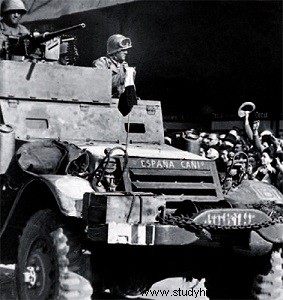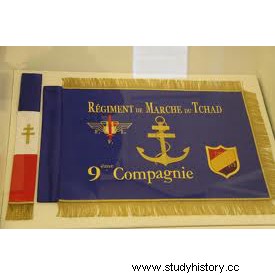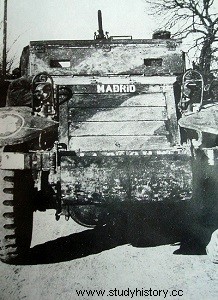
The 9th company of Chad's marching regiment, which made itself part of the 2nd Armored Division or Division Leclerc, was nicknamed la Nueve (number "nine" in Spanish). This company enlisted 160 men, including 146 Spanish republicans, often anarchists, but also French soldiers, under French command. All had fought during the Liberation of North Africa, then participated in the liberation of France.
His best known feat of arms is the participation in the liberation of Paris, since the men of La Nueve were the first to enter the French capital on the evening of August 24, 1944 with halftracks bearing the names of battles of the First World War. Spain, "Teruel", "Guadalajara", carefully renamed for the ceremonies of the following day August 25, "Montmirail", "Champaubert" or "Romilly", and elements of the engineers.
History
Origins and formation of the 9th Company
On June 22, 1940, Germany imposed an armistice on France. The territories of French North Africa join the Vichy government. He was wary of Spanish refugees, Republicans who fled Francoist Spain after 1939. These refugees were forced to choose between forced labor in mainland France, enlistment in the Foreign Legion or repatriation to Spain. For obvious reasons, most veterans of the Spanish Civil War choose to be integrated into the French army. After the Allied landings of November 8, 1942 in North Africa, the French authorities created the Corps franc d'Afrique, a regular corps for non-French combatants, such as Captain Buiza, a former admiral in the Republican Navy. It is largely made up of Spaniards. They participated in the fighting from December 1942 against the Afrika Korps in Tunisia. The fighting continued during the first half of 1943, until the conquest of the port of Bizerte, which marked the end of the fighting in North Africa.
The choice was made to the Spaniards to integrate the Leclerc division or the forces of General Giraud, who had just joined the Free French forces. The Leclerc division had been formed from May 1943 under the name of 2nd Free French Division, then in August after the merger of the FFL and the Army of Africa, under its final name of 2nd Armored Division, under the command of General Leclerc, in Libya. Most of the Spaniards joined Leclerc's units. It had 16,000 men, including 2,000 Spaniards at the beginning of 1943. They were particularly numerous in the 9th company, 1st company of the 3rd battalion, which earned it the name of La Nueve or La Española. It was placed under the command of Frenchman Raymond Dronne. Most of the men were socialists, communists, anarchists or anti-Franco non-inserts, others were deserters from concentration camps reserved for Spanish refugees in Algeria or Morocco. They were indeed soldiers of the French army, by no means an autonomous army, although they were allowed to display the republican tricolor on their uniforms. The company being almost entirely Spanish, the language used and the management (NCOs, officers) were also Spanish.
In September 1943, the company, with the entire division, was transferred to Rabat, Morocco, where the division received American equipment:160 M4 Sherman battle tanks, 280 M3 and M-8 Greyhound half-track armored vehicles, Dodge, GMC, Brockway, Diamond trucks and many jeeps. The Spaniards gave their vehicles original names, mostly reminiscent of the events of the Spanish Civil War. The jeep of the control unit is called "Mort aux idiots" and the halftrack "Les Cossaques". The 1st combat section baptizes its vehicles "Don Quichotte", "Cap Serrat", "Les Pingouins" after the nickname "Espingouins" given by the French soldiers to the Spaniards (the name of "Buenaventura Durruti", proposed by anarchists , is refused by the French superiors), “Madrid” and Guernica. The 2nd combat section gives its seshaltracks the names of "Resistance", "Teruel", "España Cañi" (then "Liberation"), "We Here" and "Ebro". The 3rd combat section baptizes its own "Tunisie", "Brunete", "Admiral Buiza", "Guadalajara", "El Canguro" and "Santander"; the names of "Catapult", "Belchite", Rescousse for the recovery halftrack are also used. Crews of Spanish origin were also allowed to paint the flag of the Second Spanish Republic on their armored vehicles.

Operations:from Normandy to Berchtesgaden
The Leclerc division was transferred from Morocco to Great Britain and did not land in Normandy until the beginning of August 1944. The 9th company landed on Utah Beach on the night of July 31 to August 1, 1944. The 2nd DB was then integrated into the 3rd US Army, led by General George Patton. La Nueve is engaged in combat against German units around Château-Gontier and Alençon. From August 13 to 18, the company fought in the vanguard of the division at Écouché. It takes 130 German soldiers prisoner. On the 16th, the Waffen-SS Adolf Hitler and Das Reich divisions, the 9th and 116th Panzer divisions and the 3rd Parachute Division attacked the 2nd Armored Division:the fighting lasted until the arrival of the 2nd British Army as reinforcements. The character of the anarchists fighting in unity is revealed during this battle:a unit of mortars thus made a coup de main 3 km behind the German lines on August 14, taking 130 prisoners and also seizing 13 vehicles, and freeing 8 Americans.
The city of Paris rises against the German occupation, on August 20, 1944. Charles de Gaulle insists with the supreme command of the allied forces that the free French troops support this insurrection. De Gaulle supports Leclerc, who wants to take advantage of the French Resistance insurrection to quickly liberate Paris. On August 23, 1944, the company set off with the entire division, heading for Paris. On August 24, around 8 p.m., the 9th company, accompanying a platoon of tanks from the 501st RCC, entered Paris through the Porte d'Italie. It was Lieutenant Amado Granell's section that reached City Hall first, at 9 p.m. Among the units arriving at the Place de l'Hôtel-de-Ville, the halftrack "Ebro" fired the first shots against a set of German machine guns. Lieutenant Amado Granell, former anarchist captain of the Iron Column, is the first “French” officer received by the National Council of the Resistance. While awaiting the capitulation of the German General von Choltitz, Governor of Paris, La Nueve is sent to occupy the Chamber of Deputies, the Hotel Majestic (headquarters of the Gestapo in Paris) and the Place de la Concorde. On the afternoon of August 25, at 3:30 p.m., the German garrison surrendered, while General von Choltitz was taken prisoner by three Spaniards, including a civilian living in Paris, before being handed over to a French officer. .
The next day, the Allied troops enter Paris in triumph. The Spaniards take part in the Victory Parade and form General de Gaulle's escort on the Champs-Elysées. They parade wearing the colors of the Second Spanish Republic, and for a few minutes a giant banner in the same colors opens the parade28. Subsequent protests from the Franco regime are ignored by the French government. The 9th Company was quartered in the Bois de Boulogne from August 27 to September 9, before returning to fight. On September 12, the company stood out at Andelot, where 300 German soldiers were taken prisoner. On the 15th, the men of the Nueve crossed the Moselle at Châtel-sur-Moselle and established a bridgehead facing the German lines. General de Gaulle recognizes the value of unity, and on September 26, he personally presents decorations to soldiers in the city of Nancy. The captain, Raymond Dronne, the Canarian sub-lieutenant Miguel Campos, the Catalan sergeant Fermín Pujol and the Galician corporal Carmiño López receive the Military Medal and the War Cross 1939-1945. The fighting in Alsace began in November 1944. On November 23, the Nueve entered Strasbourg, the last major occupied French city. On January 1, 1945, Captain Dronne paid tribute to them in a letter:
“The Spaniards fought remarkably well. They are tricky to command but they have tremendous courage and great combat experience. Some are going through a clear moral crisis due to the losses suffered and especially to the events in Spain. »

The 2nd DB was released at the end of February for fifty days of rest, in the Chateauroux region. At the end of April, it resumed fighting until the capture, on May 5, of the "Eagle's Nest", in Berchtesgaden. At this time, the losses of the 9th company amounted to 35 dead and 97 wounded. Only 16 Spaniards remained active in the Nueve, many having been assigned to other units of the French army. At the end of the war, some followed Leclerc to Indochina, some left with armored vehicles in the direction of Franco's Spain, while others returned to civilian life accepting the French nationality offered to them in order to have fought within the French troops.
More than fifty members of the company received the Croix de guerre.
Postership and tributes
The role of these Spaniards quickly fell into oblivion. Today, rare are the soldiers of the Nueve still alive, but their part in the Liberation of France, and especially of Paris, is reconsidered.
It was on August 25, 2004 that the city of Paris officially paid tribute to the Spaniards of “La Nueve”. A plaque "To the Spanish Republicans, main component of the Dronne column" was inaugurated on Quai Henri-IV, in the presence of Bertrand Delanoë, the President of the Spanish Senate, Francisco Javier Rojo, the Spanish Ambassador, Francisco Villar, and of two survivors, Luis Royo Ibañez and Manuel Fernandez. A similar plaque was placed in Square Gustave-Mesureur, Place Pinel (Paris 13th), another in the center of Place Nationale, (Paris 13th).
On February 24, 2010, the mayor of Paris presented the Grande Médaille de Vermeil to Manuel Fernandez, Luis Royo Ibañez and Raphaël Gomez
On August 25, 2012, anarchist activists who came to celebrate the memory of the libertarian fighters of La Nueve during the public ceremony, were arrested for "illegal assembly".
In 2014, the August association organized events to commemorate the 70th anniversary of the liberation of Paris, in the presence of Rafael Gomez
In March 2015, in Paris, the garden of the Hôtel de Ville was renamed "Jardin des Combattants de la Nueve"; a ceremony is planned in the presence of the King and Queen of Spain Felipe VI and Letizia as well as the Mayor of Paris Anne Hidalgo. However, the crash of Germanwings flight 9525, in which 51 Spaniards were killed, cut short the visit of the royal couple; the inauguration ceremony is then postponed to June 3, 2015
